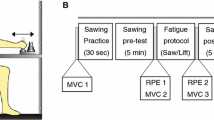Abstract
Studies of rapid, single degree-of-freedom movements have shown different changes in electromyographic patterns for movement tasks that appear very similar (e.g., movements over different ranges of distance). However, it is not clear whether these differences are a result of joint-specific control schemes or whether they are instead due to the limited range of task parameters studied relative to the mechanical constraints of each joint (e.g., short compared with long movements relative to the range of motion of a particular joint). In this study, we measured and compared the kinematic trajectories and electromyograms recorded during various movement tasks at the wrist, elbow, and ankle. Subjects performed movements over a wide range of distances “as fast as possible,”“at a comfortable speed,” and against two inertial loads (at the elbow only), and they performed movements over a fixed distance at three different speeds at the wrist and ankle. For fast movements we show that, in spite of some joint-specific differences, the basic pattern of electromyographic (EMG) modulation is similar at all three joints; for example, the agonist EMG burst transitions from a fixed duration to an increasing duration with increasing movement distance at all three joints. Moreover, the distance at which this transition occurs in one joint relative to the distance at which this transition occurs in the other two joints is consistent across subjects. The transition occurs at the shortest distance at the ankle and the longest distance at the wrist. In general we suggest that the data are consistent with a single set of control rules applied at all three joints, with the biomechanical constraints at each joint accounting for the differences in the EMG and kinematic patterns observed across joints.
Similar content being viewed by others
Author information
Authors and Affiliations
Additional information
Received: 3 September 1996 / Accepted: 10 June 1997
Rights and permissions
About this article
Cite this article
Pfann, K., Hoffman, D., Gottlieb, G. et al. Common principles underlying the control of rapid, single degree-of-freedom movements at different joints. Exp Brain Res 118, 35–51 (1998). https://doi.org/10.1007/s002210050253
Issue Date:
DOI: https://doi.org/10.1007/s002210050253




